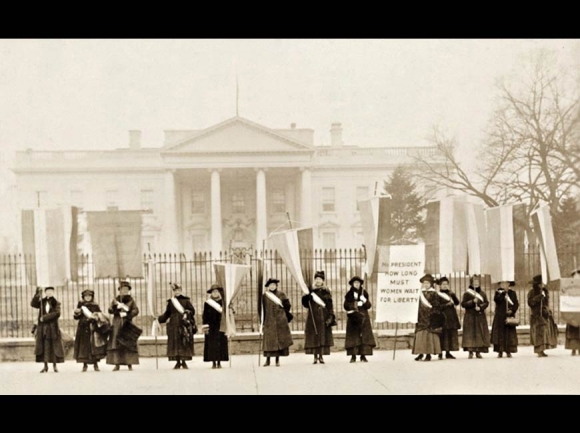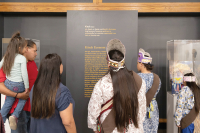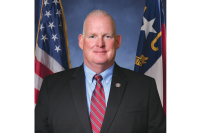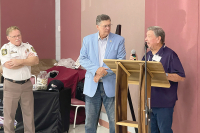Women’s Suffrage Timeline — 1840-1920

- 1840 — Lucretia Mott and Elizabeth Cady Stanton are barred from attending the World Anti-Slavery Convention held in London, which prompts them to hold a Women’s Convention in the U.S.
- 1848 — Seneca Falls, New York is the location for the first Women’s Rights Convention. Elizabeth Cady Stanton writes “The Declaration of Sentiments” creating the agenda of women’s activism for decades to come.
- 1849 — The first state constitution in California extends property rights to women.
- 1850 — Worcester, Massachusetts, is the site of the first National Women’s Rights Convention. Frederick Douglass, Paulina Wright Davis, Abby Kelley Foster, William Lloyd Garrison, Lucy Stone and Sojourner Truth are in attendance. A strong alliance is formed with the Abolitionist Movement.
- 1851 — At a women’s rights convention in Akron, Ohio, Sojourner Truth, a former slave, delivers her now memorable speech, “Ain’t I a woman?”
- 1852 — The issue of women’s property rights is presented to the Vermont Senate by Clara Howard Nichols. This is a major issue for the Suffragists. “Uncle Tom’s Cabin” by Harriet Beecher Stowe, is published and quickly becomes a bestseller.
- 1853 — Women delegates, Antoinette Brown and Susan B. Anthony, are not allowed to speak at The World’s Temperance Convention held in New York City.
- 1861-1865 — During the Civil War, efforts for the suffrage movement comes to a halt. Women put their energies toward the war effort.
- 1866 — Elizabeth Cady Stanton and Susan B. Anthony form the American Equal Rights Association, an organization dedicated to the goal of suffrage for all regardless of gender or race.
- 1868 — Elizabeth Cady Stanton, Susan B. Anthony, and Parker Pillsbury publish the first edition of The Revolution. This periodical carries the motto “Men, their rights and nothing more; women, their rights and nothing less!”
- 1868 — In Vineland, New Jersey, 172 women cast ballots in a separate box during the presidential election.
- 1868 — Senator S.C. Pomeroy of Kansas introduces the federal Women’s Suffrage amendment in Congress.
- 1868 — The Fourteenth Amendment is ratified. “Citizens” and “voters” are defined exclusively as male.
- 1869 — The American Equal Rights Association is wrecked by disagreements over the Fourteenth Amendment and the question of whether to support the proposed Fifteenth Amendment, which would enfranchise Black American males while avoiding the question of Women’s Suffrage entirely.
- 1869 — Elizabeth Cady Stanton and Susan B. Anthony found the National Women’s Suffrage Association (NWSA), a more radical institution, to achieve the vote through a Constitutional amendment as well as push for other women’s rights issues.
- 1869 — Lucy Stone, Henry Blackwell, Julia Ward Howe and other more conservative activists form the American Women’s Suffrage Association (AWSA) to work for Women’s Suffrage through amending individual state constitutions.
- 1870 — The Fifteenth Amendment gave black men the right to vote. NWSA refused to work for its ratification and instead the members advocate for a Sixteenth Amendment that would dictate universal suffrage. Frederick Douglass broke with Stanton and Anthony over the position of NWSA.
- 1870 — The Woman’s Journal is founded and edited by Mary Livermore, Lucy Stone, and Henry Blackwell.
- 1871 — Victoria Woodhull addresses the House Judiciary Committee, arguing women’s rights to vote under the Fourteenth Amendment. The Anti-Suffrage Party is founded.
- 1872 — Susan B. Anthony casts her ballot for Ulysses S. Grant in the presidential election and is arrested and brought to trial in Rochester, New York. Fifteen other women are arrested for illegally voting. Sojourner Truth appears at a polling booth in Battle Creek, Michigan, demanding a ballot to vote; she is turned away.
- 1872 — Abigail Scott Duniway convinces Oregon lawmakers to pass laws granting a married woman’s rights such as starting and operating her own business, controlling the money she earns, and the right to protect her property if her husband leaves.
- 1874 — The Woman’s Christian Temperance Union (WCTU) is founded by Annie Wittenmyer. With Frances Willard at its head (1876), the WCTU became an important proponent in the fight for women’s suffrage. As a result, one of the strongest opponents to women’s enfranchisement was the liquor lobby, which feared women might use their vote to prohibit the sale of liquor.
- 1876 — Susan B. Anthony and Matilda Joslyn Gage disrupt the official Centennial program at Independence Hall in Philadelphia, presenting a “Declaration of Rights for Women” to the Vice President.
- 1878 — A Women’s Suffrage Amendment is proposed in the U.S. Congress. When the 19th Amendment passes 41 years later, it is worded exactly the same as this 1878 Amendment.
- 1887 — The first vote on Women’s Suffrage is taken in the Senate and is defeated.
- 1888 — The National Council of Women in the United States is established to promote the advancement of women in society.
- 1890 — NWSA and AWSA merge and the National American Women’s Suffrage Association is formed. Stanton is the first president. The Movement focuses efforts on securing suffrage at the state level.
- 1890 — Wyoming is admitted to the Union with a state constitution granting Women’s Suffrage.
- 1890 — The American Federation of Labor declares support for Women’s Suffrage.
- 1890 — The South Dakota campaign for Women’s Suffrage loses.
- 1890-1925 — The Progressive Era begins. Women from all classes and backgrounds enter public life. Women’s roles expand and result in an increasing politicization of women. Consequently the issue of Women’s Suffrage becomes part of mainstream politics.
- 1892 — Olympia Brown founds the Federal Suffrage Association to campaign for women’s suffrage.
- 1893 — Colorado adopts Women’s Suffrage.
- 1894 — 600,000 signatures are presented to the New York State Constitutional Convention in a failed effort to bring a Women’s Suffrage amendment to the voters.
- 1895 — Elizabeth Cady Stanton publishes The Woman’s Bible. After its publication, NAWSA moves to distance itself from Stanton because many conservative suffragists considered her to be too radical and, thus, potentially damaging to the suffrage campaign.
- 1896 — Mary Church Terrell, Ida B. Wells-Barnett, and Frances E.W. Harper among others found the National Association of Colored Women’s Clubs.
- 1896 — Utah joins the Union with full suffrage for women.
- 1896 — Idaho adopts Women’s Suffrage.
- 1903 — Mary Dreier, Rheta Childe Dorr, Leonora O’Reilly, and others form the Women’s Trade Union League of New York, an organization of middle- and working-class women dedicated to unionization for working women and to Women’s Suffrage.
- 1910 — Washington State adopts Women’s Suffrage.
- 1910 — The Women’s Political Union organizes the first suffrage parade in New York City.
- 1911 — The National Association Opposed to Women’s Suffrage (NAOWS) is organized. Led by Mrs. Arthur Dodge, its members included wealthy, influential women, some Catholic clergymen, distillers and brewers, urban political machines, Southern congressmen, and corporate capitalists.
- 1911 — The elaborate California suffrage campaign succeeds by a small margin.
- 1912 — Women’s Suffrage is supported for the first time at the national level by a major political party, Theodore Roosevelt’s Bull Moose Party.
- 1912 — 20,000 suffrage supporters join a New York City suffrage parade.
- 1912 — Oregon, Kansas, and Arizona adopt Women’s Suffrage.
- 1913 — In 1913, suffragists organized a parade down Pennsylvania Avenue in Washington, D.C. The parade was the first major suffrage spectacle organized by the National American Women’s Suffrage Association (NAWSA).
- 1913 — The two women then organized the Congressional Union, later known at the National Women’s Party (1916). They borrowed strategies from the radical Women’s Social and Political Union (WSPU) in England.
- 1914 — Nevada and Montana adopt Women’s Suffrage.
- 1914 — The National Federation of Women’s Clubs, which had over two million women members throughout the U.S., formally endorses the suffrage campaign.
- 1915 — Mabel Vernon and Sara Bard Field are involved in a transcontinental tour which gathers over a half-million signatures on petitions to Congress.
- 1915 — 40,000 march in a NYC suffrage parade. Many women are dressed in white and carry placards with the names of the states they represent.
- 1915 — Pennsylvania, New Jersey, New York, and Massachusetts continue to reject Women’s Suffrage.
- 1916 — Jeannette Rankin of Montana is the first woman elected to the House of Representatives. Woodrow Wilson states that the Democratic Party platform will support suffrage.
- 1917 — New York women gain suffrage. Arkansas women are allowed to vote in primary elections.
- 1917 — National Woman’s Party picketers appear in front of the White House holding two banners, “Mr. President, What Will You Do For Women’s Suffrage?” and “How Long Must Women Wait for Liberty?”
- 1917 — Jeannette Rankin of Montana, the first woman elected to Congress, is formally seated in the U.S. House of Representatives.
- 1917 — Alice Paul, leader of the National Woman’s Party, was put in solitary confinement in the mental ward of the prison as a way to “break” her will and to undermine her credibility with the public.
- 1917 — In June, arrests of the National Woman’s party picketers begin on charges of obstructing sidewalk traffic. Subsequent picketers are sentenced to up to six months in jail. In November, the government unconditionally releases the picketers in response to public outcry and an inability to stop National Woman’s Party picketers’ hunger strike.
- 1918 — Representative Rankin opens debate on a suffrage amendment in the House. The amendment passes. The amendment fails to win the required two thirds majority in the Senate.
- 1918 — Michigan, South Dakota, and Oklahoma adopt Women’s Suffrage.
- 1918 — President Wilson states his support for a federal Women’s Suffrage amendment. Wilson addresses the Senate about adopting Women’s Suffrage at the end of World War I.
- 1919 — The Senate finally passes the Nineteenth Amendment and the ratification process begins.
- Aug. 18, 1920 — Tennessee adopts Women’s Suffrage.
- Aug. 26, 1920 — Three quarters of the state legislatures ratify the Nineteenth Amendment. American women win full voting rights.
Source: National Women’s History Museum









